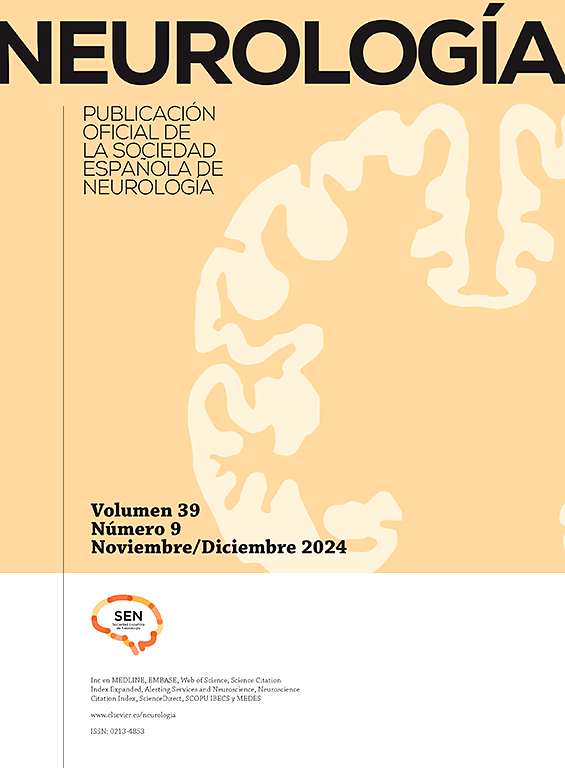Estado de la neurosonología en España. Un estudio de la Sociedad Española de Neurosonología (SONES)
IF 3.1
4区 医学
Q2 CLINICAL NEUROLOGY
引用次数: 0
Abstract
Introduction
Neurosonology is the field of study of the ultrasound techniques applied to neurological diseases. The Spanish Society of Neurosonology –SONES– was funded in 1997 to promote training and education in these techniques, especially focused on the study of cerebrovascular diseases. After 25 years, the increased use of other advanced neurovascular imaging techniques and the emergence of novel applications of ultrasound in other fields of neurology have modified the classic role of neurosonology. From the SONES we aimed to evaluate the current status of neurosonology in Spain.
Methods
Cross-sectional survey of neurologists and neurology residents working in Spain regarding training, education, and local daily practice, including a strengths, weaknesses, opportunities and threats –SWOT– analysis.
Results
One-hundred seventy-eight neurologists and 34 neurology residents participated in the survey. A wide experience in vascular neurosonology (90% of respondents’ Neurology departments) and limited experience in brain parenchyma sonography (34%), cardiac echoscopy (25%), ultrasound-guided techniques (24%), and nerve ultrasound (14%) was reported. Fifty-three percent of the participants reported to have a full-time neurosonology lab in their department and only 14% reported to have neurologists dedicated exclusively to neurosonology. Most participants (53%) reported to lack continuous learning opportunities, and 97% to need training in one or more neurosonology techniques. Main SWOT were requiring expertise, shortage of time, versatility and comprehensive management of the neurological patient, respectively.
Conclusions
Vascular neurosonology is widely instituted in Spain, but the implementation of full-time neurosonology labs and training in non-vascular neurosonology techniques is yet scarce.
西班牙神经病学的现状。西班牙神经生理学学会(SONES)的研究
神经超声学是研究应用于神经系统疾病的超声技术的领域。西班牙神经声学学会(sones)于1997年获得资助,以促进这些技术的培训和教育,特别侧重于脑血管疾病的研究。25年后,其他先进的神经血管成像技术的使用增加,超声在神经学其他领域的新应用的出现,改变了神经超声的传统作用。从SONES中,我们旨在评估西班牙神经声纳学的现状。方法对在西班牙工作的神经科医生和神经科住院医师进行横断面调查,调查内容包括培训、教育和当地日常实践,包括优势、劣势、机会和威胁- swot分析。结果178名神经科医师和34名神经科住院医师参与了调查。他们在血管神经超声方面经验丰富(90%的应答者来自神经内科),而在脑实质超声检查(34%)、心脏超声检查(25%)、超声引导技术(24%)和神经超声检查(14%)方面经验有限。53%的参与者报告说他们的部门有一个全职的神经超声实验室,只有14%的人报告说他们有专门从事神经超声的神经科医生。大多数参与者(53%)报告缺乏持续学习的机会,97%需要接受一种或多种神经超声技术的培训。主要的SWOT分别是需要专业知识、时间短缺、通用性强和神经系统患者综合管理能力强。结论西班牙已广泛开展血管神经超声检查,但尚未建立专职的神经超声实验室和开展非血管神经超声技术培训。
本文章由计算机程序翻译,如有差异,请以英文原文为准。
求助全文
约1分钟内获得全文
求助全文
来源期刊

Neurologia
医学-临床神经学
CiteScore
5.90
自引率
2.60%
发文量
135
审稿时长
48 days
期刊介绍:
Neurología es la revista oficial de la Sociedad Española de Neurología y publica, desde 1986 contribuciones científicas en el campo de la neurología clínica y experimental. Los contenidos de Neurología abarcan desde la neuroepidemiología, la clínica neurológica, la gestión y asistencia neurológica y la terapéutica, a la investigación básica en neurociencias aplicada a la neurología. Las áreas temáticas de la revistas incluyen la neurologia infantil, la neuropsicología, la neurorehabilitación y la neurogeriatría. Los artículos publicados en Neurología siguen un proceso de revisión por doble ciego a fin de que los trabajos sean seleccionados atendiendo a su calidad, originalidad e interés y así estén sometidos a un proceso de mejora. El formato de artículos incluye Editoriales, Originales, Revisiones y Cartas al Editor, Neurología es el vehículo de información científica de reconocida calidad en profesionales interesados en la neurología que utilizan el español, como demuestra su inclusión en los más prestigiosos y selectivos índices bibliográficos del mundo.
 求助内容:
求助内容: 应助结果提醒方式:
应助结果提醒方式:


